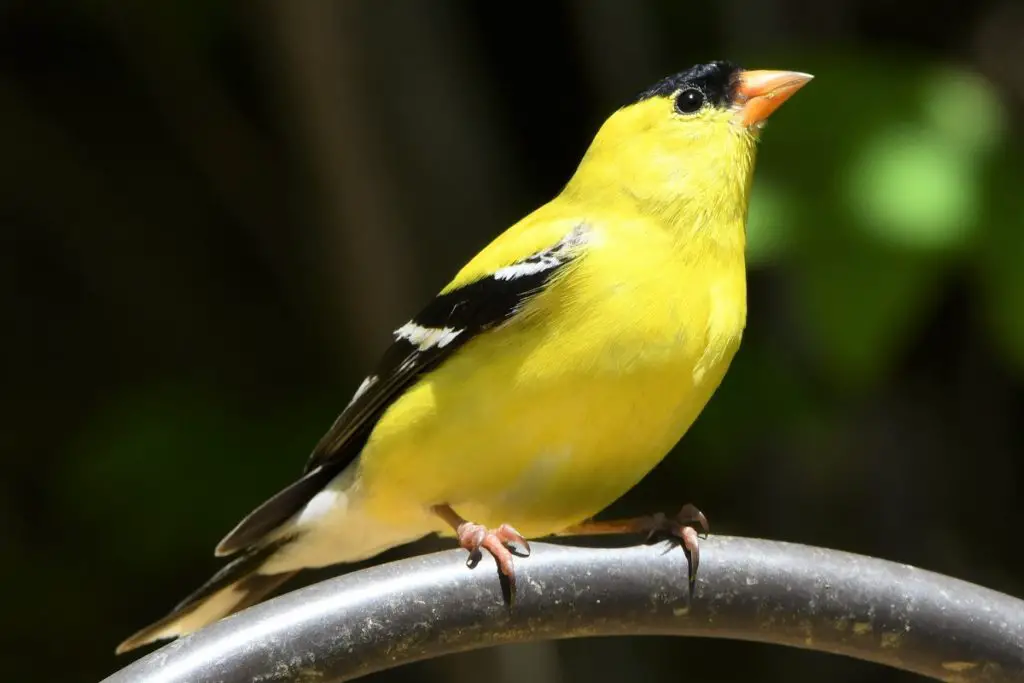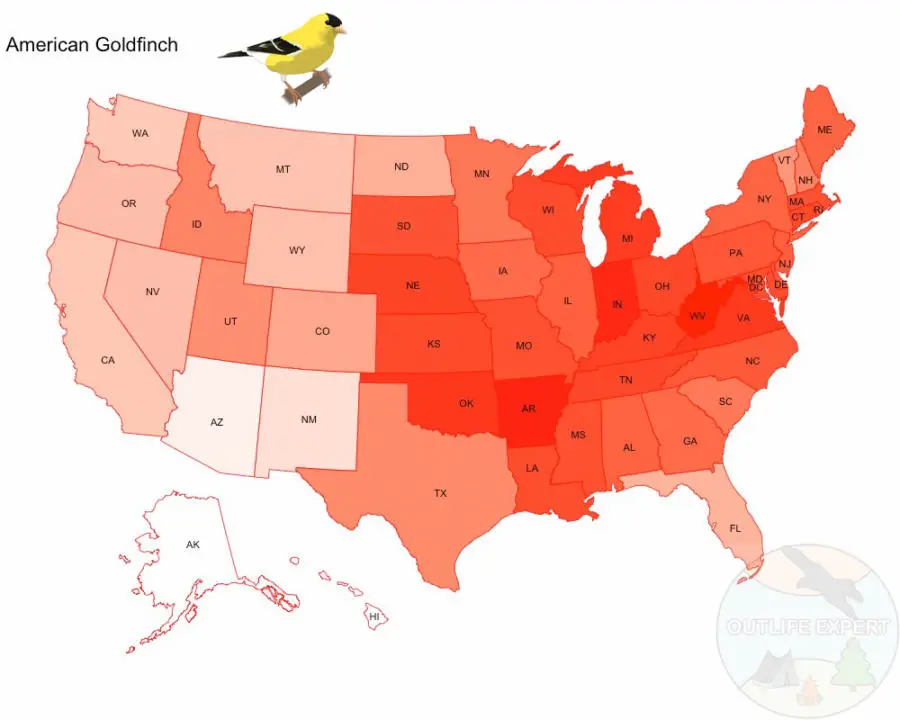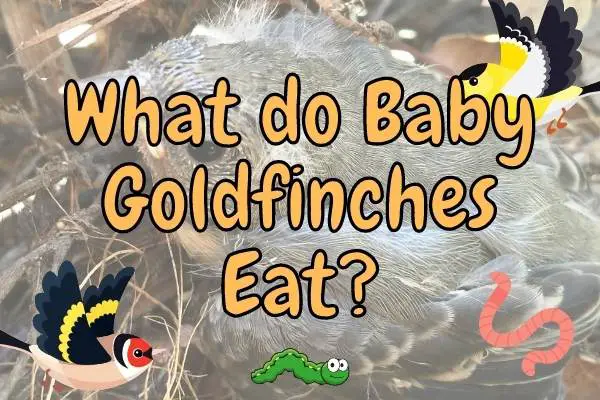The babies of the American Goldfinch are referred to as nestlings. At this stage in life, the little ones are still very much dependent on their mother for survival. As far as diet goes, food will be brought to them by both parents.
This diet of baby Goldfinches consists mainly of softer insects like worms that the parents catch and feed to them. After 2-5 weeks, they are able to catch their own broader variety of insects and eat seeds.
As they get older their diet consists of a variety of different things like bugs and worms, seeds from plants and trees, grasses and grains, and maybe even some small spiders – which mom catches for herself but passes on to her babies.
Contents
Fact box: The American Goldfinch (Spinus tristis)

American Goldfinch summary:
Family: Fringillidae
Occurrence: Southern Canada to California in the summer. Also Florida and Mexico in winter.
Diet in the wild: Seeds, insects.
Feeder type preferences:
- Large tube feeder
- Small tube feeder
- Ground feeder
- Large hopper feeder
- Small hopper feeder
- Platform feeder
Feeder food preferences:
- Black Oil Sunflower Seeds
- Hulled Sunflower Seeds
- Nyjer (Thistle) seeds
Endangered: No.
The American goldfinch is a small garden bird commonly found in large flocks throughout the US, southern Canada, and central Mexico. As short-distance migratory birds, they move south during the winter to escape the cold.
During summer they are found from southern Canada to California and North Carolina. During winter, they can be found from Washington to Nova Scotia south into central Mexico.
Their natural habitat is open meadows, but they often flock towards bird feeders in suburban areas. They are the official state bird of three US states: Iowa, New Jersey, and Washington.

The stronger the red color, the higher the chance that you will see the American goldfinch in your backyard.
The American goldfinch belongs to the Fringillidae (finch) family.
There are four subspecies: the eastern goldfinch, the pale goldfinch, the northwestern goldfinch, and the willow goldfinch.
Other closely related species include the lesser goldfinch, Lawrence’s goldfinch, and the siskins. Despite the similar-sounding name, they are not related to the European goldfinch.
Identifying the American goldfinch
The American goldfinch is a 4 to 6-inch, brown to yellow bird with a white undertail. Their wings and tail are black with white markings. In summer, the male is easily distinguishable with his bright yellow plumage and black cap.
The male is very recognizable due to its bright yellow color.
The female is brown with a pale-yellow underside in the summer months with an olive-colored head and back. In winter, both males and females are olive-brown with a yellowish head. Juvenile fledglings are a dull brown with pale yellow undersides.
Their call is a chirpy “tseee-tsi-tsit-tsit”.
Subspecies can be distinguished by their distribution and small variations in coloration and size.
The eastern goldfinch is the most common and most eastern subspecies. They occur from Colorado eastwards from southern Canada to central Mexico.
The slightly larger pale goldfinch, as its name suggests, has a paler body, stronger white markings, and a larger black cap in the male. They have a more western range stretching from British Columbia to western Ontario south to Mexico.
The northwestern goldfinch is darker and smaller compared to the other subspecies. They occur along the coastal slope of the Cascade Mountains from southern British Columbia to central California.
What do baby American Goldfinches eat?
Baby American Goldfinches are nestlings and as such, they eat different things than older goldfinches. When nestlings are able to leave the nest, they turn into fledglings or young adults, which are able to find their own food.
Baby Goldfinches are mostly fed by their parents and they eat a lot of insects like worms and larvae. In the wild, adult goldfinches feed on insects too.

Fledglings also occasionally eat nectar from flowers but unlike adults, baby American Goldfinches don’t have a developed tongue for this task.
Their parents make a supply of insect larvae and put it in their nest for the golden babies. The insects that they feed on are mostly soft-bodied like worms, caterpillars, and some beetles. They can also offer them hardbody bugs such as ladybirds (ladybugs), small grasshoppers, crickets, etc.
They do not eat larger or hostile insects such as bees, as goldfinches are simply not able to catch these, let alone eat them without being stung!
As they grow older they start to eat small pieces of fruit and seeds. Insects are good for their health, especially in the winter when they don’t get a chance to feed on berries that grow in summer or fall.
How To Feed a Baby American Goldfinch?
Here are some tips on how to feed a baby American Goldfinch.
Whereas adult goldfinches can eat wild bird seed mixes, baby goldfinches cannot digest larger seeds or other hard food items yet.
Therefore it is generally best to feed baby goldfinches soft worms as their parents would do.
The best insects to feed a goldfinch are mealworms, wax worms or small earthworms and larvae from your yard, and other easily digested worms.
As these worms are often quite big, it is recommended that you chop them up and feed the soft contents of the worms using something soft like a brush instead of a spoon.
Another way to make nutrient-rich food for the birds when they get about older is by blending seeds into readily digestible slurry!
Make your own birdseed mixes by combining several types of grains, seeds, and other ingredients available to you.
Mix sunflower seeds with safflower seeds, nyjer, or canary grass seeds. You should also add some peanuts into this mix because these are high in fat and protein too.
Soak the seeds overnight in 5 times their weight in water and then put your special mix into a blender and blend till all seeds are turned into liquid slurry without clumps!
You can also offer American Goldfinch some blended fruits such as apple, pear, and orange because these foods contain sugars, and citrus fruit is packed with Vitamin C. Just remember not to feed them grapes because the seeds can be poisonous.
How about food for fledglings?
After the baby goldfinches are two to three weeks old, they can start to eat more solid foods.

The easiest food for them when they are old enough is sunflower seeds which you can offer in a separate feeder or mix with other bird foods. If too big, offer them grass or nyjer seeds instead. Alternatively, chop the sunflower seeds into a food processor.
Place a feeder around the house or around the yard where you have released the fledgling goldfinches.
Especially near the trees where great tit, tree sparrows, or finches live are good options.
Does the Male American Goldfinch Also Take Care of the Babies?
Yes, the male American Goldfinch takes care of the babies. Like most bird species, the male and female build nests and raise their young together.
Both parents bring food for their young ones to feed them until they are ready to fly away from the nest. They also take care of the females who sit on the eggs.
Goldfinches mate in the months of April and May but they breed only once a year. You can start looking for their nest in March or early April when these birds are ready to mate.
The female is in charge of building the nest out of thin branches, grasses, roots, moss, etc. She makes a cup-shaped nest in which she lays 4-5 eggs.
The female sits on the eggs until they hatch but during this time, the adult parent birds need more food like nyjer or canary seeds, fruits, and insects.
These foods contain proteins and lots of energy that are very important for their health and provide them enough energy to take proper care of their young.
You can help the parents get enough energy for raising their babies by placing a bird feeder with seeds or mealworms nearby.
You can also place it in a window to attract adult goldfinches and other birds that you like. Make sure that the feeder is easy for your birds to use by attaching it in a way that is easily accessible.
Make sure that the food doesn’t spoil with rain or sun because this can harm or even kill birds. So place it under the roof or another form of shelter. Also remember that when you refill the bird feeder, some seeds will fall to the ground.
The best time to feed your birds is in the morning or late afternoon, especially during winter or colder days when these birds can’t go out and forage.
However, there are some types of goldfinches that visit bird feeders even during nightfall so you can try feeding them at dusk too. Don’t feed your American Goldfinches when you have a cat in your garden because this will only attract the cat and it may harm birds.

After leaving the nests, both males and females take care of the babies through their fledgling days.
Can You Breed Goldfinches in Captivity?
Yes, you can breed goldfinches in captivity, but it is not recommended as they are wild birds and should stay like that!
However, if you feel that a young goldfinch is unable to survive in the wild, the only option might be to take it in. But always consult your local vet before making these decisions yourself!
In case you have to take care of goldfinches, you should provide them with shelter during cold days and shelter them from the sun during hot days. You can keep at least two goldfinch couples together for breeding because they are not aggressive towards each other.
What Do You Do If You Find an Abandoned Baby Goldfinch?
Here are some tips on what you should do if you find an abandoned baby goldfinch.
In case you find a baby goldfinch in your garden, make sure not to touch it too much as it will scare the bird, although it is a myth that their parents will not take them back if you do so!
First, place the bird in a dark, warm, and quiet environment. You can put the bird into a box equipped with soft tissues or paper that will allow them to have warmth. Put another tissue around it to stop it from sticking onto the bird.
Do not force any sort of liquids or food into their beaks unless they are very weak because the bird may choke on this.
The best way to feed them is by putting the food into their mouths using a clean dropper or syringe when they open up their beak on their own.
You can feed them up to eight times a day, however, don’t overfeed them just enough for them to swallow the food easily.
Don’t give the bird too much fruit because this may cause it to have diarrhea. However, you can give them water using a dropper. Keep in mind that overfeeding is bad for birds so only put enough liquid into the dropper so that they can swallow or lick it easily. You should also feed them insects like mealworms now and then.
If you decide to take care of a found baby goldfinch, make sure that it gets enough warmth and/or sunlight especially during cold winter days when birds cannot go outdoors and forage. Install an infrared bird bulb to provide the right amount of warmth if you keep it outside.
Conclusion
Goldfinches are a very beautiful type of American bird that is characterized by their yellow and black color. They can live in both the wild and in captivity.
Whereas baby goldfinches need a high-protein diet of soft insects like larvae, when goldfinches come out from their nests, they can eat high-protein human food items like canary seeds or thistle-dried flavored flowers, etc.
However there are many other options, you can feed them as well if they are not too expensive for your budget. You should also put a birdbath in their aviary to provide water because birds need fresh water every day.
Although you might be able to help a baby goldfinch for some time, remember that they are always better off with their parents.
But remember: If you find a baby bird, always consult your local animal hospital or veterinarian before doing anything else.
Backyard birds in North America
Are you interested in how the backyard birds in your state compare to other states?
Then check out my other blog posts below:
- Backyard birds of Alabama
- Backyard birds of Colorado
- Backyard birds of Delaware
- Backyard birds of Georgia
- Backyard birds of Hawaii
- Backyard birds of Illinois
- Backyard birds of Iowa
- Backyard birds of Kentucky
- Backyard birds of Louisiana
- Backyard birds of Maryland
- Backyard birds of Massachusetts
- Backyard birds of Missouri
- Backyard birds of Nebraska
- Backyard birds of New York
- Backyard birds of North Carolina
- Backyard birds of Oklahoma
- Backyard birds of Rhode Island
- Backyard birds of South Carolina
- Backyard birds of Tennessee
- Backyard birds of Texas
- Backyard birds of Virginia
- Backyard birds of West Virginia
- Backyard birds of Wisconsin
- Backyard birds of Wyoming
Or in Canada:
- Backyard birds of Ontario
- Backyard birds of Prince Edward Island
- Backyard birds of Saskatchewan
- Backyard birds of Quebec
Not on the list – check out the rest of my posts on backyard birds here!
Maybe you would like to know if the Blue Jay or Cardinal dominates in the bird feeder hierarchy or how birds such as seagulls sleep at night?
If you are interested in posters and other wall arts etc. with drawings of all the backyard birds you have just read about, check out my portfolio over at Redbubble:





